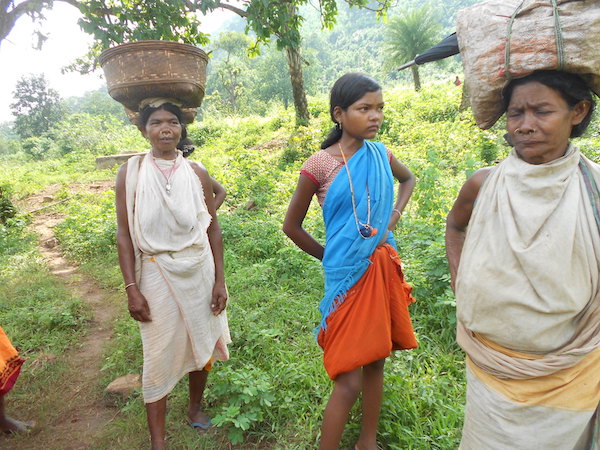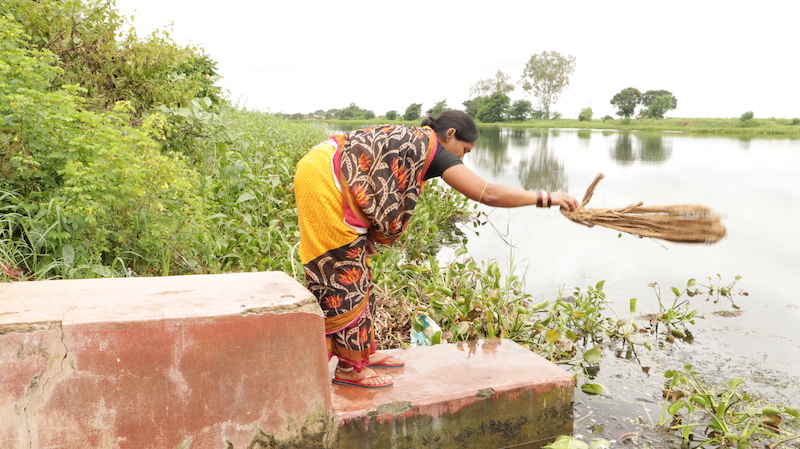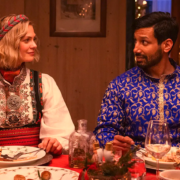Fabric of Life On the Edge: The Endangered Weavers of Kotpad and Niyamgiri in Odisha
- Although sari is the most popular garment of Indian women, these hand-woven saris made by the indigenous communities and the traditional heritage of these weavers are endangered because of the allure of cheap machine-made synthetic saris flooding the market.

COVID-19 has had a devastating impact all over the world. While people in the United States are approaching the beginning of the end of the pandemic, it is creating havoc in India. The poor have been affected Disproportionately. Similarly the lives and livelihood of weavers have been devastated. The weavers of Kotpad village and the Dongria Kondhs of Niyamgiri in Odisha are no exception.
The Kotpad saris are a vegetable-dyed handloom fabric, woven by the tribal weavers of the Mirgan community of Kotpad village in the Koraput district of Odisha. They exemplify the legacy of living in harmony with nature. These textiles are made of natural products, Aal tree bark and roots, the principal source for natural coloring. Aal trees grow abundantly in the dense forests of Koraput, Malkangiri, and Umerkote in Odisha due to natural and climatic conditions, which are rare elsewhere. These trees play a vital role in the life, skills, and occupation of Kotpad weavers. They procure the dried roots of this tree from the local market.
The Kotpad hand-crafted saris are locally known as Adivasi Pata (textiles from the original inhabitants), woven by the Panika community of Kotpad village, who have been weaving the textile for different indigenous communities in the area, highlighting their respective motifs, making the fabric a visual code and a cultural symbol.

In the last decade, the Kotpad saris, shawls, and stoles have been in great demand, both within India and abroad, because of their all-natural thread, the motif tied to nature, the lifestyle of the weavers, and their unique way of processing the dye in making this sari.
The Panikas share their weaving tradition with the adjoining villages — Bastamba, Masinga and Baipariguda. The Koraput region is historically the home to tribes like the Bhatra, Muria, Gonda, Munda, Oraon, Santhal, Kondh, and Bondo. It came under the modern state of Odisha in 1936 after being ruled by several royal dynasties.
The Panikas claim to be disciples of the medieval Sant Kabir, a great reformer and promoter of the Bhakti movement. Kabir did not make any distinction between Ram and Rahim (Hindu and Islam). He belonged to a weaver caste, and the Panikas identify with him.
Forty-nine-year-old Prahlad Mahato, a well-known master weaver from the village, says that they follow Kabir dharma and are Kabir Panthis, who practice nonviolence, shun alcohol, and embrace simple living. “Our ancestors followed Kabir as the God. We go to his kabarstan (burial) in the neighboring town Damakheda in Chhattisgarh. Now we practice the Hindu religion and celebrate Nua Khia Parba (festival) and Guru Purnima for Kabir Jayanti in the month of Kartik to commemorate his birthday.”
The Panikas take great pride in expressing their symbiotic relationship with their Adivasi neighbors. The Indian Census classifies Panikas as Scheduled Caste. However, they claim their affinity to the Adivasis based on their lifestyle, common sentiments, and the harmonious process of weaving their saris connecting to nature.
Mahato, who is president of the Kotpad Weavers’ Cooperative Society, says that they dispute their Scheduled Caste identity as their “achaar and byabahar” (conduct and behavior) goes along with the Adivasis. They are known as peaceful people who believe in a simple lifestyle without competing with each other. “They are very egalitarian.”
For a better understanding of the making of Kotpad textile, here is a documentary
Harmonious Division of Labor
In Kotpad, men and women participate equally in making the textiles. Women prepare the indigenous dye, dry it and get it ready for the loom. Men weave and market the cloth. Women use the ancient dyeing technique to extract red color from the Aal root, using castor oil, cow dung, and wood ash, an elaborate and laborious process that goes on for a month. Despite the use of castor oil, there is no shine or smell. Instead, the cloth becomes soft and the colors get lustrous and vibrant.
The dyed coarse cotton yarn, ranging from 10 to 20 counts, is woven in a simple but highly evolved three-shuttle pit loom with extra weft patterning for the more complicated motifs. The primary colors extracted are maroon and black. This natural textile prevents skin rash, keeps one warm during cold, feels cool in summer, and looks elegant.
Traditionally the pata (sari) is shorter and narrower than the six-yard length of most saris. Adivasi women wear it up to their knee-length and cover the upper portion of their body without a blouse, and the ends are knotted on one side of the shoulder. Adivasi men usually wear a plain loincloth and occasionally drape a handwoven towel on their bare shoulders.
The beauty of the pata lies in the unbleached or off-white coarser textured cotton body (deh) accented with a deep al color red border (dhadi) on both ends of the sari. This handcrafted textile is rendered individually with intricate motifs and patterns representing the social and cultural context of Adivasi pata. The temple borders such as Kumbha, Kena, bundki adds a distinctive and bold identity to the tribal textiles.
Due to the exorbitant cost of this sari, and with the advent of cheap synthetic textile and scarcity of natural resources, Adivasi women wear it on special occasions. Depleting Natural Resources Kotpad sari-making has been under threat. With massive deforestation, the number of Aal trees,the primary source of the natural dye, has fallen drastically. Earlier, it was abundantly available in the local forests. But due to the limits imposed by the forest department, the local tribal women are finding it difficult to collect the Aal root barks.

Binaya Bhusan Jena, a professor at the National Institute of Fashion Technology (NIFT), Bhubaneswar writes that “the price of dried Aal roots has gone up three times per domota (around 14 kgs) from about Rs. 500 to Rs. 700/ (75 cents to a dollar) to Rs. 1800/- to 2200/ (about $3) in recent times.”
The weavers earlier used ponds in the village for dyeing and processing of yarn. These ponds are auctioned to grow fish in the current times, and the weaver’s face restriction. They are not allowed to use the water for washing their thread dipped in cow dung and are blamed for dirtying the pond water.
The boiling and processing of dye and yarn require wood. Earlier, the weavers used to collect wood from the local forests, but due to forest department restrictions, they now have to buy wood from the local market, adding extra cost.
Why are the Weavers Suffering?
With the advent of power looms and cheap factory-made garments, Kotpad weaving lost its traditional market. From 200 families in Kotpad practicing this age-old craft, Mahato says that now “20 to 30 families are engaged with weaving using about 25 looms. There are only seven master weavers in the village. But the majority of them have closed down their looms.
Kapileswar Mahanta, a renowned master weaver, has no work. Many weavers, especially the younger generation, have moved to other menial jobs due to economic pressure.
Due to the absence of any institutional mechanism for working capital, the weavers face exploitation at the hands of money lenders, master weavers, and intermediaries. Recently, the weavers had access to credits through the Weavers Credit Card initiated by the state. But the process of getting it from the bank is too long. In some cases those who received the funds had already abandoned weaving after a long wait. Therefore the majority of them could not repay the loan. The banks are now reluctant and not ready to offer any credit to the weavers again.
The saris, made with natural products are time-consuming to weave, as a result, relatively expensive. An exquisite and straightforward Kotpad cotton sari costs about $200; people without knowledge of the culture and the beauty of the material would not share the sentiments and value of this sari.
In 2005, Kotpad natural dyed handloom fabric received a Geographical Indication (GI) protection for unique traditional knowledge and products. There are many designers and non- governmental organizations (NGOs) promoting sustainable fashion and natural dyed handloom fabric. Despite all such initiatives, the new generations of artisans do not find this craft lucrative and are moving to other professions.

Many of the Kotpad weavers have no access to the state and the central government’s government schemes. The procurement mechanism of supporting the making of Kotpad saris benefits only the master weavers in the name of co-operative. With the intervention of a few freelance designers, NGOs, and some traders, the weavers have created new products for niche markets. But this is not regular and only limited to the reputed master weavers. There is no flow of work for the weavers. Any order to the weavers goes through the master weavers or moneylenders who eat away the significant profit.
The Predicament of Younger Weavers
Mahato says that the state government has been enticing the younger weavers with several schemes like housing under the Karmashala Yojana for establishing the pit loom; loan under Mudra Yojana; and helping with the loom and accessories under Saranjam Yojana, Still, young weavers are not very enticed to be in this profession. Before Covid, a family used to earn ₹4,000 per sari after putting in 12-15 days of intense labor. Weaving is their sole vocation, but they cannot make more than two saris because of the laborious process. Now a family gets ₹3,000 wages for a sari with much less work, and they can make a maximum of four saris in a month. Every weaver has to report to a master weaver for capital, networking, and marketing.
Mahato admits that the sari sale has declined due to Covid, because of lack of sales opportunities through exhibitions, handloom sari shows, conferences, workshops, and meetings. “We used to be invited to handloom exhibits in the state and all over the country to showcase our saris. Now it has stopped,” he says. There is also the attraction of more lucrative professions. One young man noted that if he became a mason, he would get ₹500 per day, compared to the maximum of ₹ 300 from the loom, that too only if the sari sells. Mahato talks about his son, who does coloring and helps him with the business. His daughters also help their mother with dying the thread. Prior to Covid, Mahato had 20 pit looms running. Now it has shrunk to five.
The Dangria Kondh Textiles: Kapdagonda
Another textile that’s popular in the state is the Dongaria textile, which depicts the Niyamagiri mountain, known as the habitat of Dongria Kondhs. It is prominently worn mainly by the women in all their religious rituals. The myths and legends associated with the textile narrate the story of the Niyamgiri hills of creation. They call themselves the children of Niyam Raja (King of Justice) and look at Niyamgiri as the creator, protector, and nurturer and follow his rules ‘niyam Ku niyam’ for their wellbeing.
The Kondhs live in the upper reaches of the Niyamgiri hills, in the southwest of Odisha. They derive their name from danger or hill. The Niyamgiri hills are the sole habitat of this group, whose distinctive identity is evident in their unique language, livelihood, social structure, and religious practices.
While studying the protest movement of the Dongria Kondhs to stop mining in Niyamgiri, I was introduced to their textile. Their beautiful cloth (locally called kapdagonda) narrates the story of Niyamgiri hills and nature, and the Dongria Kondh women are engaged in making it. I fell in love with it.
Kondh Women and Textiles
The women wear kapdagonda, covering their body around their waist, and cover their breasts with another piece of cloth. Pankaja Sethi, a designer who studied their textile, says, “Kondh women explained to me how every line and pattern had a name and meaning. The purpose of rendering textile is not to show their excellence, and it is their artistic expression – a legacy of tradition, an identity which is what I want to stress.”

Women play a significant role in making this textile from spinning, weaving, warping, and dyeing along with household activities. Their role is hardly recognized for the contribution towards heirloom tradition. Unfortunately, this textile is now replaced by the cheap synthetic white and red cloth sold by outside merchants in their haats (local market).
Women spend the whole day collecting food and fodder from the mountains and taking care of their children at home. Weaving consumes a lot of time and is becoming more expensive. As a result, this cloth is losing its value, and weaving traditions are becoming extinct.
Like Dongria textile, Kerang cloth, made by Gadaba Adivasi women, the earliest example of bark cloth has languished in the name of development. Adivasi Kuli Meher ikat weavers are among the vulnerable weavers in western Odisha. The Barkcloth of Bonda Adivasi women has disappeared; the state has not revived this rare indigenous cloth. The authentic Bomkai weavers in Ganjam are struggling to make a living. The quilting practiced by Ganjam women is not recognized as a craft by the state.
It is evident that although sari is the most popular garment of Indian women in India and the Indian diaspora, these hand-woven saris made by the indigenous communities and the traditional heritage of these weavers are endangered because of the allure of cheap machine-made synthetic saris flooding the market and the Chinese machines taking over the traditional handloom.
Annapurna Devi Pandey teaches Cultural Anthropology at the University of California, Santa Cruz. She holds a Ph.D. in sociology from Jawaharlal Nehru University, New Delhi, and was a postdoctoral fellow in social anthropology at Cambridge University, U.K. Her current research interests include diaspora studies, South Asian religions, and immigrant women’s identity making in the diaspora in California. In 2017-18 she received a Fulbright scholarship for field work in India. Dr. Pandey is also an accomplished documentary filmmaker. Her 2018 award-winning documentary “Road to Zuni,” dealt with the importance of oral traditions among Native Americans.



congratulations your thinking and approach is very pragmatic. please keep it up best wishes